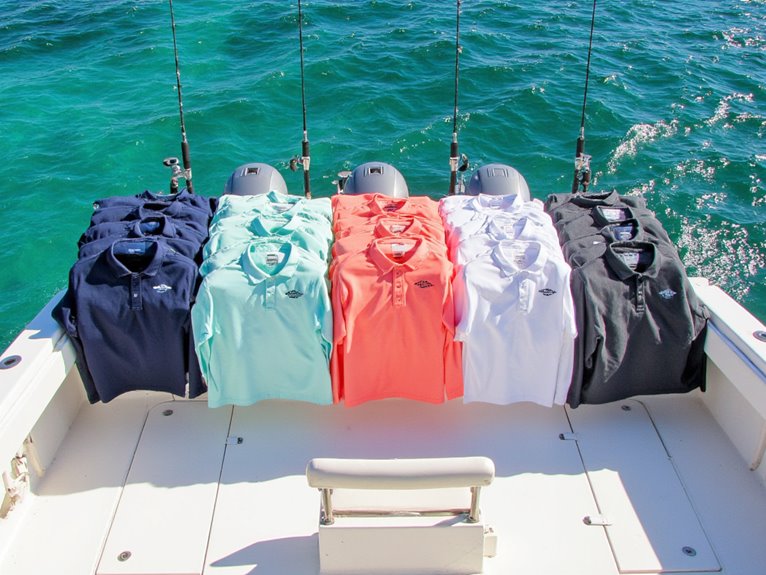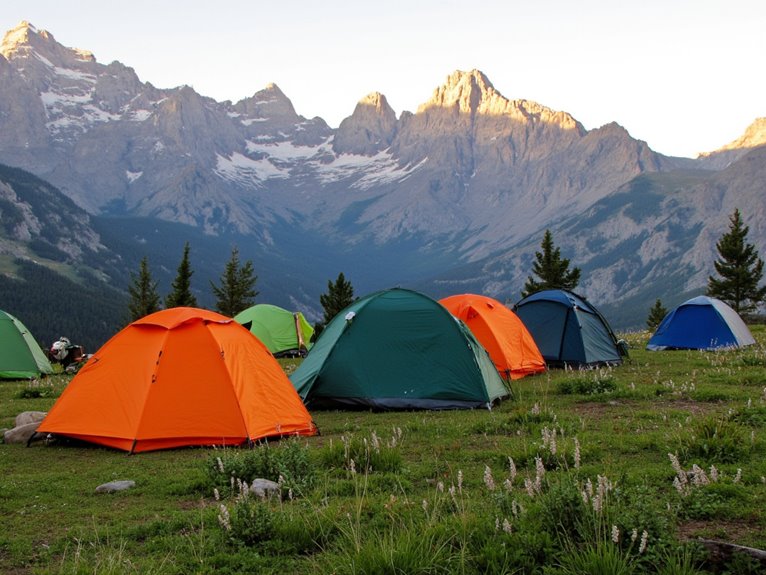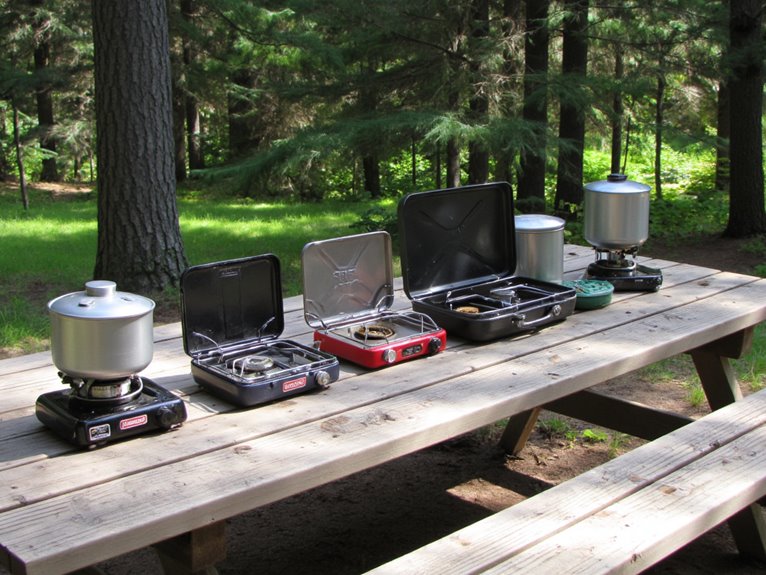Is It Warmer to Sleep With Clothes on or off in a Sleeping Bag?
Wearing clothes to bed in a sleeping bag can be counterproductive, as it can trap moisture close to the skin, leading to condensation and discomfort. In mild temperatures, sleeping naked may be the best option. However, in colder conditions, wearing thin, moisture-wicking base layers can help retain body heat. The key is to find the right balance of clothing and sleeping bag temperature rating to maintain ideal body temperature. By understanding the intricacies of thermoregulation, sleeping bag design, and moisture management, you can discover the secrets to a comfortable night's sleep – and find the perfect approach for your next outdoor adventure.
We are supported by our audience. When you purchase through links on our site, we may earn an affiliate commission, at no extra cost for you. Learn more. Last update on 7th January 2026 / Images from Amazon Product Advertising API.
The Science of Body Heat
Human body temperature is regulated by the hypothalamus, a small region in the brain that acts as the body's thermostat, constantly monitoring and adjusting heat levels to maintain a narrow temperature range of 97.7°F to 99.5°F (36.5°C to 37.5°C).
This precise control is essential for peak bodily functions, as even slight deviations can lead to discomfort, fatigue, and impaired cognitive function.
When the body detects a temperature change, the hypothalamus triggers responses such as sweating or shivering to restore equilibrium.
This intricate thermoregulatory system is fundamental for overall health and well-being, and understanding its mechanisms is indispensable for making informed decisions about sleeping with clothes on or off in a sleeping bag.
Sleeping Bag Design and Materials
In terms of sleeping bag design and materials, several key factors contribute to a restful night's sleep.
The choice of insulating materials, fabric thickness, and moisture-wicking technology all play a vital role in regulating body temperature and maintaining comfort.
Insulating Material Choices
In the pursuit of ideal thermal insulation, sleeping bag designers carefully select materials that balance warmth, weight, and durability.
Insulating materials are typically categorized into down-filled and synthetic-filled options.
Down-filled bags utilize the natural loft and warmth of goose or duck down, offering exceptional thermal efficiency and compressibility.
Synthetic-filled bags, on the other hand, employ man-made materials like polyester or nylon to mimic the insulating properties of down.
These options are often more affordable and retain warmth when wet.
Some bags may also incorporate hybrid constructions, combining down and synthetic materials to achieve superior performance.
Regardless of the chosen material, the key to effective insulation lies in the ability to trap warm air and maintain loft, ensuring a comfortable and restful night's sleep.
Fabric Thickness Matters
The thickness of a sleeping bag's fabric plays a crucial role in its overall performance, as it directly influences the bag's ability to retain warmth, resist moisture, and withstand the rigors of outdoor use.
A fabric that is too thin may compromise the bag's insulating properties, while one that is too thick may be bulky and restrictive.
Thicker fabrics provide better insulation but may be heavier and less compressible.
Thinner fabrics are more breathable and lightweight but may sacrifice warmth.
Fabric thickness also affects the bag's water resistance, with thicker fabrics generally more resistant to moisture.
When choosing a sleeping bag, consider the balance of warmth, weight, and compressibility that suits your needs.
Moisture-Wicking Technology
Moisture-wicking technology, a key feature in modern sleeping bag design, enables the fabric to draw sweat and moisture away from the body, preventing a buildup of dampness that can compromise the bag's insulating properties.
This innovative technology guarantees that the sleeper remains dry and comfortable, even during intense physical activity or in humid environments.
By rapidly transporting moisture to the outer layer of the fabric, where it can evaporate quickly, moisture-wicking technology helps maintain a consistent body temperature and prevents the growth of bacteria and odor-causing microorganisms.
This feature is particularly essential for campers and outdoor enthusiasts who need a restful night's sleep to tackle the next day's adventures.
Clothing Types and Thermal Resistance
In selecting clothing for sleeping, the type of fabric used can greatly impact thermal resistance.
Fabrics with high thermal insulation properties, such as fleece or wool, can help retain body heat, while moisture-wicking fabrics, like polyester or nylon, can efficiently manage sweat.
The strategic layering of clothing, including insulating mid-layers, can also play a vital role in regulating body temperature during sleep.
Fabric Thermal Properties
Synthetic fabrics like polyester and nylon offer lower thermal resistance compared to natural fibers like cotton and wool, making them a popular choice for activewear and sleepwear. This is due to their molecular structure, which allows for better heat transfer and retention.
In contrast, natural fibers have a higher thermal resistance, making them more suitable for colder climates.
Thermal resistance is measured in tog units, with lower values indicating better heat transfer.
Fabrics with high thermal resistance, such as down-filled garments, trap warm air close to the body.
Fabrics with low thermal resistance, such as silk or cotton, allow for better heat transfer.
The choice of fabric depends on the desired level of warmth and the activity level of the individual.
Moisture Wicking Fabrics
Fabrics designed to manage moisture, particularly those used in activewear and sleepwear, have become increasingly popular in recent years due to their ability to improve comfort and performance during physical activities.
These moisture-wicking fabrics are engineered to draw sweat away from the skin, allowing for rapid evaporation and reducing the risk of overheating.
This technology is particularly useful for sleepwear, as it helps maintain a stable body temperature and prevents clamminess.
When choosing sleepwear, look for fabrics with high moisture-wicking properties, such as polyester, nylon, or merino wool blends.
These fabrics will help regulate your body temperature, ensuring a comfortable and restful night's sleep.
Insulating Mid-Layers
Mid-layer clothing, comprising insulating materials like fleece, down, or wool, plays an essential role in regulating body heat by trapping warm air close to the skin while allowing moisture to escape. This layer is fundamental in maintaining a comfortable sleeping temperature.
Thermal resistance depends on the type and thickness of the insulating material.
Fleece provides excellent warmth-to-weight ratio and is a popular choice for mid-layers.
Down-filled garments offer exceptional warmth but may lose insulating properties when wet.
Wool is a natural, breathable option that retains warmth even when damp, making it an excellent choice for sleeping attire.
Moisture and Condensation Factors
One key consideration in the decision to sleep with clothes on or off is the role of moisture and condensation, as even slight variations in humidity can substantially impact the body's ability to regulate its temperature during sleep.
When moisture accumulates inside the sleeping bag, it can lead to condensation, making the sleeping environment colder and less comfortable.
Wearing clothes to bed can exacerbate this issue, as clothing can trap moisture close to the skin, increasing the risk of condensation. Additionally, clothing can also reduce the breathability of the sleeping bag, further compromising its ability to manage moisture.
Sleeping Bag Temperature Ratings
When selecting a sleeping bag, understanding its temperature rating is essential, as it directly influences the level of comfort and warmth during sleep. A sleeping bag's temperature rating is the lowest temperature at which the bag is designed to keep you comfortable.
Manufacturers typically provide three ratings: comfort, limit, and extreme. It's vital to understand these ratings to make certain you're prepared for the conditions you'll encounter.
The comfort rating is the temperature at which a user can expect a good night's sleep.
The limit rating is the temperature at which a user can survive the night, but may not sleep comfortably.
The extreme rating is the minimum temperature at which the bag will keep you alive, but not necessarily comfortable.
Different manufacturers may use different rating systems, so it's necessary to research and understand the specific rating system used by your sleeping bag's manufacturer.
Real-World Testing and Experiments
While understanding temperature ratings is vital, the true test of a sleeping bag's performance lies in real-world testing and experiments, where the bag is subjected to a range of environmental conditions and user experiences.
This involves testing the bag in various temperatures, humidity levels, and wind conditions to gauge its ability to retain warmth and comfort.
Additionally, real-world testing considers factors such as user metabolism, clothing choices, and sleeping position to simulate real-life scenarios.
By putting the sleeping bag through its paces in a controlled environment, manufacturers can gather valuable data on its performance and make necessary adjustments to optimize its design.
This rigorous testing process guarantees that the sleeping bag meets the needs of outdoor enthusiasts and provides a comfortable night's sleep in a variety of conditions.
Expert Opinions and Field Tests
Eight out of ten outdoor enthusiasts agree that expert opinions and field tests provide invaluable insights into a sleeping bag's performance, offering a more nuanced understanding of its capabilities beyond laboratory testing.
These experts, including seasoned backpackers and outdoor guides, have spent countless nights in the wilderness, testing sleeping bags in real-world conditions.
Their feedback and reviews provide a wealth of knowledge on how well a sleeping bag performs in various temperatures, humidity levels, and weather conditions.
Expert opinions highlight the importance of sleeping bag features such as fill power, moisture-wicking fabrics, and draft collars in maintaining a comfortable sleeping temperature.
Field tests reveal that even the highest-rated sleeping bags can have temperature ratings that vary significantly from their advertised specifications.
Real-world testing exposes the weaknesses of certain sleeping bag designs, such as inadequate insulation or poor zipper design.
Expert reviews also emphasize the importance of proper sleeping bag maintenance, including washing and storage, to ensure optimal performance over time.
The Verdict: Clothes On or Off
Ultimately, the decision to sleep with clothes on or off largely depends on individual preferences and sleeping habits, as well as the temperature and conditions of the outdoor environment.
While some people find that wearing clothes helps regulate body heat and maintain a comfortable sleeping temperature, others prefer to sleep naked to maximize the insulation of their sleeping bag.
Generally, if the temperature is mild, sleeping naked may be the better option.
However, in colder conditions, wearing thin, moisture-wicking base layers can help retain body heat.
Ultimately, it's essential to experiment and find what works best for you.




